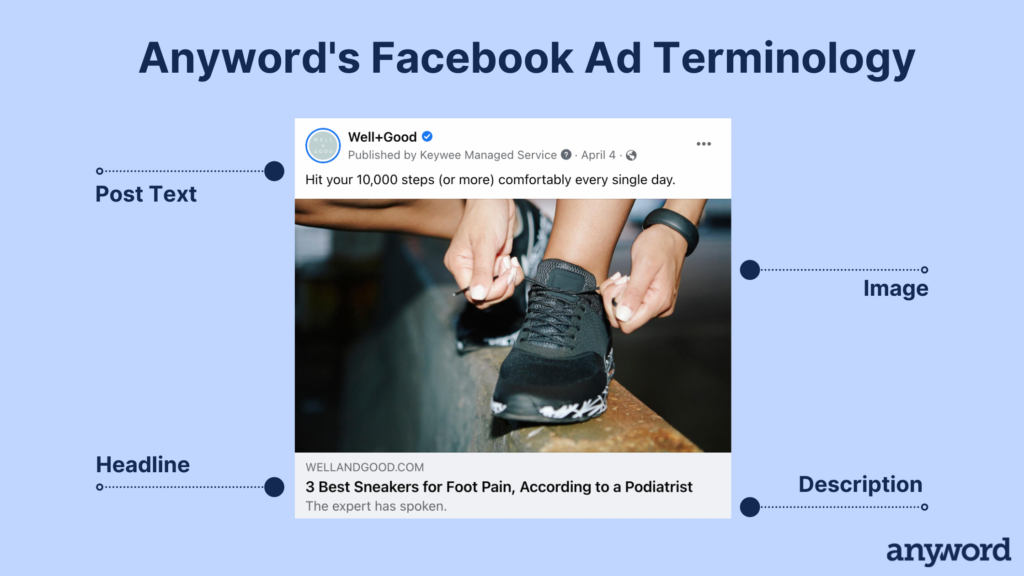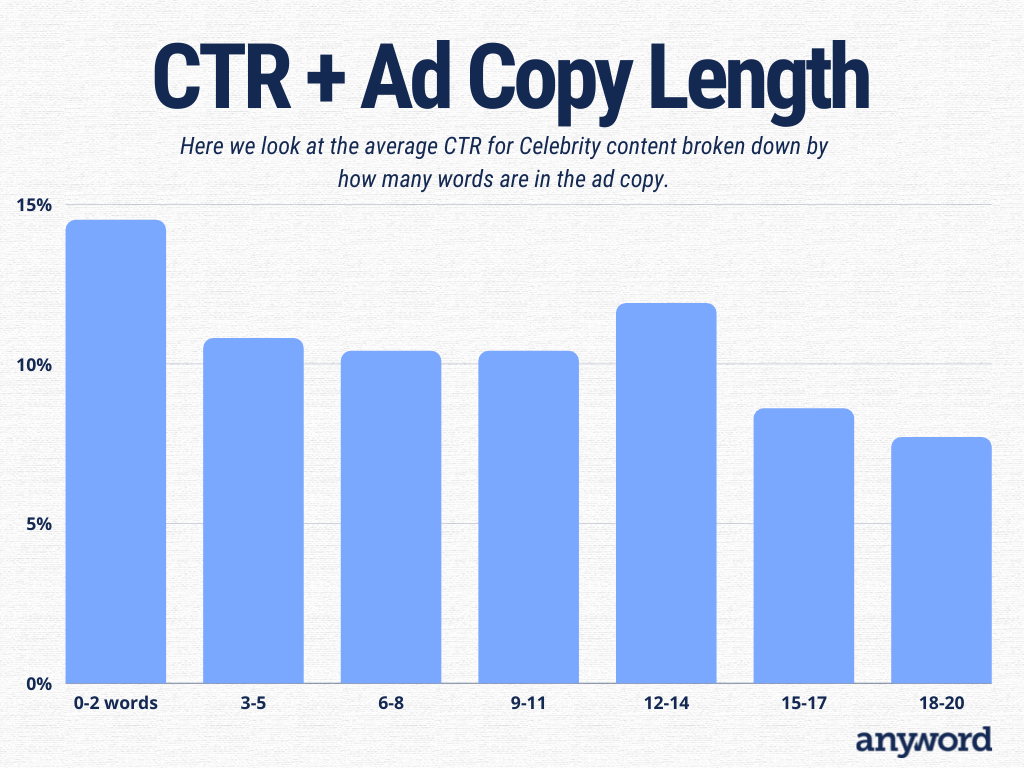This five-part series will dive into how you can take a data driven approach to Facebook Ads copywriting, using research-backed insights to improve your content’s form, targeting and engagement. We’ll look at the ideal length and structure for different elements of your Facebook ads. Headline and call-to-action best practices vary for different industries, content types and audience profiles, so we’ll take a deep dive into all. We’ll also look at what kind of words drive (or negatively impact) engagement in each element.
To kick off this series, we’re starting with ad copy length.

Out of over tens of thousands of Facebook ads we analyzed for the sake of this post, and in our findings, we see a general trend for Ad Text performing better when it is kept short. We also know that shorter isn’t always better and that informative value can be more important than ad copy length for user engagement. But can this be a bit nuanced for different content types? Are there contexts where longer ads perform better?
Let’s dive in.
Ad Length + Different Content Types
How does ad copy length influence CTR for different content types? To find the answer, we looked at over 12K ads that fall under the Celebrity category and 4.7K ads in Finance.
For the celebrity category, very short ads (about one to two words) had a 36% higher CTR than the average for celebrity content as a whole. Similarly, celebrity content with these shorter ad texts had a CTR that was 11% above the average of those with copy between 12-14 words.

And to have some content representation that’s not entertainment-related reading (celebs), we’re also going to focus on more news and education content, represented by Finance. With this, we’re examining how the mindset related to content type influences engagement and performance overall.
So, now it’s time to dig a bit deeper.
Ad Copy Structure Breakdown
Looking closer at these ad copy structures, we see that two-word ad text for Celebrity content often simply consist of the name of the specific celebrity (with maybe an emoji thrown into the mix as well). This tactic allows the reader to make a quick connection to the content they are looking at. Additionally, this type of ad copy contains enough information for the average reader to decide whether they want to engage.
The next top-performing bucket when it comes to length is the 12-14 word ads, where information balances reading length ideally. These ads often follow the structure of:
“Subject of the Article” + “Content Subject/Topic” + “Qualifying Angle or POV”
What does this look like in action? Take a look at the examples below:
- “Pop Culture Is Finally Getting Over the Girlboss Heroine. What Comes Next?”
- “Julia Roberts’ Daughter Turns 16 And Is The Spitting Image Of Her Mom”
- “William Shatner’s unique rendition of ‘Rocket Man’ resurfaces after his trip to space”
Ad Copy Length + Consumer Behavior
One reason why the 12-14 word range works so well for this type of content may be related to the way in which we read and digest content. Contrary to popular belief, we typically don’t read linearly or read every letter in every word sequentially.
Rather, we read in what is called “saccades”. These are short “jumps” or eye flickers that occur when we read a piece of text. They happen about every 1.4 seconds, during which we read about 7-9 characters on average. This typically comes to about two English words. What does this mean for our 12-14 range? A sentence in this range would equate to about six jumps, or 1.5-3 seconds for the average reader. If you want to learn more about saccades, check out this resource here.
If the ad copy isn’t simply stating a celebrity’s name (which is the shortest way to get the reader to decide whether or not they want to engage), 12-14 words seems to be the ideal balance between the time needed to read the ad and the information it carries.
When looking at Finance content, we see that overall CTRs are lower than that of Celebrity content. This is despite the fact that there is a slight advantage for short ads under five words. CTRs take a dip for more average-length ad copy. But when we look at how CTRs fare once the word count starts increasing, there’s a slight increase at around 20-23 words.

So, what can we infer from this? It seems that for a subject like Finance, where the reader expects to engage with more complex content, the ratio between ad copy length and information content is higher than for more entertainment-oriented topics.
And to put this in a more broad perspective, we can follow this general rule of thumb:
The more in-depth and complex your content, the more willing your audience will be to engage with longer ad copy.
The Benefits of Short & Long Ad Copy
Now that we know both short and long copy hold merit in different circumstances, it’s time to look at the benefits of both. Here, we’ll dive into some more broad advantages of the different copy lengths, and given the data we just presented, you can decide which tactic might work best for your content.
Benefits of Short Copy
- Skimmable and brief for your audience.
- Allows you to show off your brand’s tone in a short amount of time.
- Breaks up the Facebook feed.
- Works really well for promotions and sales.
Benefits of Long Copy
- Answers more questions and allows you to give context.
- Works well for more complex topics or products/services.
- Allows you to use quotes or testimonials.
Put Your Copy in the Hands of Anyword
So, whether you decide short or long ad copy will work best for you, turn to Anyword for all of your content creation needs.
Anyword’s AI Copywriting Platform uses industry-leading technology to generate high-quality marketing content. This AI writer helps its users create a wide variety of content — like blogs, product descriptions, landing pages, emails, and ad copy.
And of course, the platform can create Facebook posts and ads. But Anyword’s leading technology doesn’t just help users with copy generation. This AI writer also leverages a wide database of ads to provide unique Predictive Performance Scores with each copy variation you generate on the platform. These “grades” give you an indication of that specific piece of text’s conversion and performance potential — giving you a better idea of how well your copy will resonate with your specific audience. This means you can choose the top-performing copy before you even go live or hit “Publish”.
Test the waters by booking a demo today.


